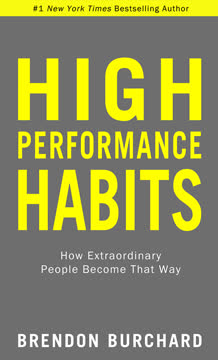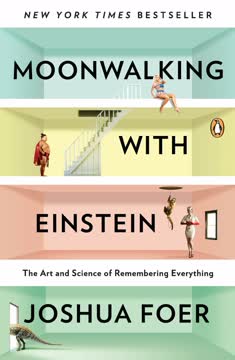Key Takeaways
1. Unlimit Your Mindset: Overcome Limiting Beliefs
"If you fight for your limitations, you get to keep them."
Identify limiting beliefs. Our mindset, shaped by past experiences and societal influences, often constrains our potential. To overcome these limitations, start by recognizing the "LIEs" (Limited Ideas Entertained) you hold about yourself and your abilities.
Challenge and reframe. Once identified, challenge these beliefs by examining the evidence supporting them. Often, you'll find these limitations are self-imposed rather than based on reality. Replace negative self-talk with empowering beliefs that align with your goals and aspirations.
Embrace a growth mindset. Adopt Carol Dweck's concept of a growth mindset, believing that your abilities can be developed through dedication and hard work. This perspective fosters resilience, encourages learning from failures, and ultimately leads to greater achievement and personal growth.
2. Harness the Power of Motivation: Purpose, Energy, and Small Steps
"Motivation = Purpose × Energy × S3"
Define your purpose. Motivation stems from a clear understanding of why you're pursuing a goal. Reflect on your values, passions, and the impact you want to make in the world. This clarity of purpose will fuel your drive and persistence in the face of challenges.
Optimize your energy. Physical and mental vitality are crucial for sustained motivation. Prioritize:
- Quality sleep
- Regular exercise
- Balanced nutrition
- Stress management techniques
Take small, simple steps (S3). Break down large goals into manageable tasks to avoid overwhelm and maintain momentum. Consistently taking action, no matter how small, builds confidence and creates a positive feedback loop of achievement.
3. Master Learning Methods: Focus, Study, Memory, and Speed Reading
"There's no such thing as a good memory or a bad memory; there is only a trained memory and an untrained memory."
Enhance focus. Cultivate concentration by:
- Eliminating distractions
- Practicing mindfulness
- Using the Pomodoro Technique (25-minute focused work sessions)
Optimize study techniques. Improve learning efficiency with:
- Active recall: Test yourself on material
- Spaced repetition: Review information at increasing intervals
- Mind mapping: Visually organize information
- Teaching others: Reinforce understanding by explaining concepts
Boost memory. Employ mnemonic devices and visualization techniques to improve retention. The Method of Loci, associating information with familiar locations, is particularly effective for memorizing large amounts of data.
Accelerate reading speed. Develop speed reading skills by:
- Using a visual pacer (finger or pen) to guide your eyes
- Expanding peripheral vision to take in more words at once
- Reducing subvocalization (silent speech while reading)
4. Unleash Your Brain's Potential: Neuroplasticity and Brain Health
"Your brain is like a muscle: use it or lose it."
Harness neuroplasticity. Your brain's ability to form new neural connections throughout life means you can continually learn and adapt. Engage in novel experiences, learn new skills, and challenge yourself mentally to strengthen these connections.
Prioritize brain health. Optimize cognitive function through:
- Regular physical exercise
- Sufficient sleep (7-9 hours nightly)
- Stress reduction techniques (meditation, deep breathing)
- Social engagement
- Continuous learning and mental stimulation
Protect against cognitive decline. Reduce the risk of neurodegenerative diseases by:
- Maintaining a healthy diet rich in omega-3 fatty acids, antioxidants, and vitamins
- Engaging in regular cardiovascular exercise
- Managing chronic health conditions (hypertension, diabetes)
- Staying socially active and mentally engaged
5. Elevate Your Thinking: Six Thinking Hats and Multiple Intelligences
"It's not how smart you are; it's how you are smart."
Apply the Six Thinking Hats. Edward de Bono's method encourages looking at problems from multiple perspectives:
- White Hat: Focus on available data and information
- Red Hat: Express emotions and intuitions
- Black Hat: Identify potential risks and obstacles
- Yellow Hat: Explore benefits and positive aspects
- Green Hat: Generate creative ideas and alternatives
- Blue Hat: Manage the thinking process and draw conclusions
Recognize multiple intelligences. Howard Gardner's theory identifies eight types of intelligence:
- Linguistic
- Logical-mathematical
- Spatial
- Musical
- Bodily-kinesthetic
- Interpersonal
- Intrapersonal
- Naturalistic
Understand your strengths and develop strategies to leverage them while improving areas of weakness.
6. Optimize Brain Nutrition: Foods, Supplements, and Nootropics
"What you eat matters, especially for your gray matter."
Consume brain-boosting foods. Incorporate:
- Omega-3 rich fish (salmon, sardines)
- Antioxidant-packed berries
- Leafy greens
- Nuts and seeds
- Dark chocolate
- Turmeric
- Eggs
Consider supplements. Key nutrients for cognitive function include:
- Omega-3 fatty acids (EPA and DHA)
- B-complex vitamins
- Vitamin D
- Magnesium
Explore nootropics. These cognitive enhancers may improve memory, focus, and overall brain function:
- Caffeine
- L-theanine
- Bacopa monnieri
- Lion's mane mushroom
- Rhodiola rosea
Always consult with a healthcare professional before starting any new supplement regimen.
7. Leverage AI to Enhance Human Intelligence
"AI is not something to be afraid of, but rather, something we can harness and integrate into our methods for learning faster and becoming limitless."
Augment, don't replace. View AI as a tool to enhance human intelligence rather than a replacement. Use AI to handle routine tasks, organize information, and provide insights, freeing up mental resources for higher-level thinking and creativity.
Personalize learning. Leverage AI-powered platforms to:
- Assess your learning style and preferences
- Create customized study plans
- Provide adaptive feedback and recommendations
Enhance productivity. Utilize AI for:
- Summarizing complex information
- Generating ideas and brainstorming
- Fact-checking and research assistance
- Language translation and learning
Remember that critical thinking, emotional intelligence, and creativity remain uniquely human strengths. Focus on developing these skills while using AI to complement and enhance your capabilities.
8. Cultivate Learning Agility in a Changing Workplace
"Learning agility leads to knowing what to do when you don't know what to do."
Embrace continuous learning. In a rapidly evolving work environment, the ability to quickly acquire new skills and adapt to change is crucial. Cultivate a growth mindset and view challenges as opportunities for growth.
Develop transferable skills. Focus on building competencies that are valuable across industries and roles:
- Critical thinking
- Communication
- Emotional intelligence
- Adaptability
- Collaboration
- Digital literacy
Practice reflective learning. Regularly assess your experiences, successes, and failures to extract valuable lessons. Use techniques like:
- Journaling
- Peer feedback
- Mentorship
- Personal SWOT analysis (Strengths, Weaknesses, Opportunities, Threats)
By developing learning agility, you'll be better equipped to navigate uncertainty, seize new opportunities, and thrive in an ever-changing professional landscape.
Last updated:
FAQ
What's Limitless Expanded Edition by Jim Kwik about?
- Focus on Learning: The book emphasizes enhancing your brain's capabilities to learn faster and more effectively, offering strategies for improving memory, reading speed, and cognitive function.
- Core Framework: It revolves around three pillars: mindset, motivation, and methods, which help readers unlock their potential and achieve their goals.
- Neuroscience Insights: Kwik integrates neuroscience to explain brain optimization, helping readers understand the principles of learning and memory.
Why should I read Limitless Expanded Edition by Jim Kwik?
- Unlock Your Potential: The book provides actionable steps to break free from self-imposed limitations, leading to personal and professional growth.
- Practical Techniques: It includes easy-to-implement techniques like the FASTER method and MOM mnemonic for memory improvement, offering immediate results.
- Lifelong Learning: Kwik encourages a mindset of lifelong learning, essential for adapting and thriving in today's fast-paced world.
What are the key takeaways of Limitless Expanded Edition by Jim Kwik?
- Mindset Matters: A limitless mindset is crucial for overcoming obstacles and achieving success, emphasizing that your past does not dictate your future.
- Active Learning Techniques: Methods like active recall and spaced repetition enhance retention and understanding, encouraging engagement with material.
- Nutrition and Brain Health: Proper nutrition is vital for brain health, with specific foods and supplements enhancing cognitive function.
What are the best quotes from Limitless Expanded Edition by Jim Kwik and what do they mean?
- “If we all did the things we are capable of doing, we would literally astound ourselves.”: Encourages pushing beyond perceived limits to achieve greatness.
- “Your brain is not a piece of obsolete technology; it’s a remarkable tool that needs to be sharpened continually.”: Highlights the importance of continuous learning and brain training.
- “Knowledge is not power; it’s potential power.”: Stresses that knowledge must be applied effectively to realize its potential.
How does Limitless Expanded Edition by Jim Kwik address the impact of nutrition on brain health?
- Brain Nutrition Importance: Proper nutrition is essential for optimal brain function, supporting cognitive abilities and mental performance.
- Specific Foods: Highlights brain-boosting foods like omega-3 fatty acids and antioxidants, crucial for maintaining brain health.
- Nootropics and Supplements: Explores supplements that enhance cognitive performance, advising consultation with healthcare professionals.
What is the FASTER method in Limitless Expanded Edition by Jim Kwik?
- Forget Distractions: Let go of distractions and preconceived notions to focus on learning.
- Actively Engage: Engage actively by taking notes, asking questions, and participating in discussions to deepen understanding.
- State Management: Manage emotional and physical states to enhance focus and retention, making learning more effective.
How can I improve my memory using techniques from Limitless Expanded Edition by Jim Kwik?
- Active Recall: Test yourself on material to strengthen memory by actively retrieving information.
- Spaced Repetition: Review information at increasing intervals to reinforce memory and prevent forgetting.
- Visualization Techniques: Use mental images or stories to enhance memory retention, making information easier to recall.
How does Limitless Expanded Edition by Jim Kwik suggest overcoming limiting beliefs?
- Identify Limiting Beliefs: Encourage self-reflection to identify and challenge limiting beliefs.
- Reframe Your Thoughts: Transform negative thoughts into positive affirmations to shift mindset and open new possibilities.
- Cultivate a Growth Mindset: View challenges as growth opportunities, fostering resilience and encouraging learning.
What role does mindset play in Limitless Expanded Edition by Jim Kwik?
- Mindset Shapes Reality: Emphasizes that mindset influences how we perceive and interact with the world.
- Growth Mindset: Encourages adopting a growth mindset to overcome limiting beliefs and unlock potential.
- Beliefs and Success: Changing beliefs can lead to new possibilities and success, as mindset is a key factor in personal development.
How can I apply the concepts from Limitless Expanded Edition by Jim Kwik to my daily life?
- Set Clear Goals: Use SMART criteria to set specific, achievable goals for personal and professional development.
- Practice Daily: Incorporate techniques like active recall and spaced repetition into daily routines for reinforced learning.
- Embrace Lifelong Learning: Continuously seek new experiences and knowledge to expand horizons and adapt to changes.
What is the Brain Animal C.O.D.E. in Limitless Expanded Edition by Jim Kwik?
- Understanding Brain Types: Categorizes individuals into four brain types: Cheetah, Owl, Dolphin, and Elephant, each with unique cognitive strengths.
- Tailored Learning Strategies: Adopting strategies that align with your brain type enhances learning and performance.
- Improving Interactions: Understanding different brain types fosters better collaboration and communication, valuing diverse perspectives.
How does Limitless Expanded Edition by Jim Kwik define motivation?
- Purpose-Driven: Motivation is driven by understanding your "why," crucial for sustaining motivation.
- Energy Management: Effective energy management is essential for maintaining high motivation levels.
- Small Simple Steps: Breaking tasks into manageable steps prevents overwhelm and encourages consistent progress.
Review Summary
Limitless receives mixed reviews. Some praise its practical techniques for improving memory, reading speed, and learning ability. Others criticize it as repetitive, self-promotional, and lacking originality. Positive reviewers find the book motivating and helpful for personal growth. Critics argue it rehashes common self-help concepts and contains excessive filler. Many note that much of the content is available in Kwik's online materials. Overall, readers' experiences vary widely, with some finding it transformative and others dismissing it as marketing-driven and superficial.
Similar Books








Download PDF
Download EPUB
.epub digital book format is ideal for reading ebooks on phones, tablets, and e-readers.




